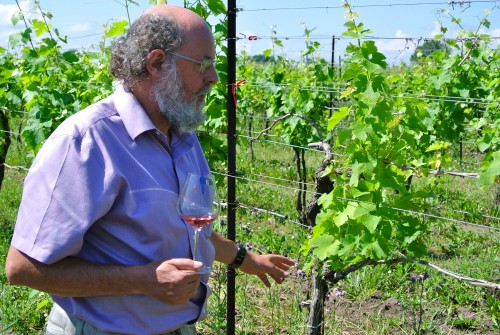 Stratus likes to call it “the right to free assemblage.” Therein lies the philosophy behind everything the Niagara-on-the-Lake winery does with its wine program.
Stratus likes to call it “the right to free assemblage.” Therein lies the philosophy behind everything the Niagara-on-the-Lake winery does with its wine program.
The art of the blend forms the basis of the hierarchy at Stratus; first establish the top tier Stratus Red and White from the best grapes produced at the estate then work down from there. The two top wines are everything, the rest just gravy to fill the shelves at the elegantly appointed retail store on Niagara Stone Road.
It explains, partially, why winemaker J-L Groux shows no signs of stress as we strolled through the estate’s main vineyard earlier this summer. We see signs of damage from the winter’s polar vortex, dead wood (photo below) on some of the more vulnerable varieties, but Groux just shrugs it off. There will be a Stratus Red and a Stratus White in 2014 but the blend could be drastically different.
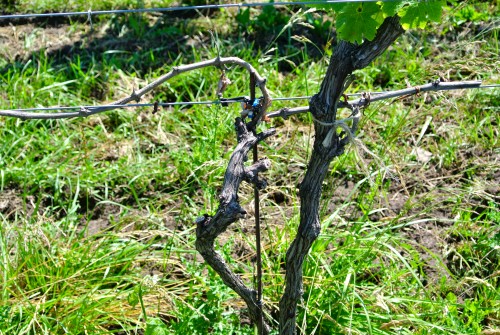 All over Niagara, varietals such as Merlot and Sauvignon Blanc, two mainstays of the top Stratus Red and White, were hit hard. Syrah, too, was laid waste from the cruel winter of 2014.
All over Niagara, varietals such as Merlot and Sauvignon Blanc, two mainstays of the top Stratus Red and White, were hit hard. Syrah, too, was laid waste from the cruel winter of 2014.
In a Canadian Press report by Maria Babbage this week, the situation looks grim for some varieties. Bud survival rates for Sauvignon Blanc ranged from 8% along Lake Erie’s North Shore to 51% at Four Mile Creek in central Niagara-on-the-Lake, according to the latest data provided by the VineAlert program.
The survival rates for Merlot ranged from 4% at Lake Erie’s North Shore to 64% along the Niagara lakeshore.
Stratus has the luxury of shaking up its blend to play to its strengths. With 18 different grape varieties grown on its 62-acre property, one of the largest selections of grapes in the peninsula, the art of the blend becomes crucial in a vintage such as 2014.
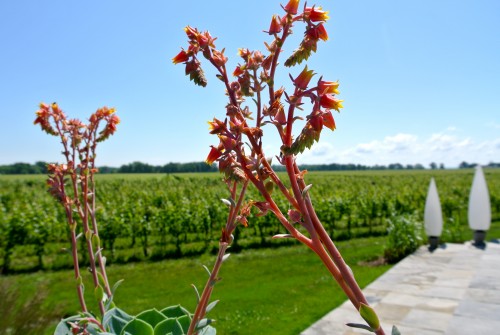 The long-used Stratus phrase “a whole greater than the sum of its parts” does not ring hollow in the tough years. Stratus will simply find the best of the best for its top assemblages, drawing on the entire vineyard as its palette, to create its next incarnation of the top wines. From there, it bottles single-variety wines as it sees fit, a second wine called Wildass, and sells the rest as bulk wine that’s not bottled by Stratus.
The long-used Stratus phrase “a whole greater than the sum of its parts” does not ring hollow in the tough years. Stratus will simply find the best of the best for its top assemblages, drawing on the entire vineyard as its palette, to create its next incarnation of the top wines. From there, it bottles single-variety wines as it sees fit, a second wine called Wildass, and sells the rest as bulk wine that’s not bottled by Stratus.
It’s a recipe that gives Groux the full confidence to take a walk in the vineyard in the summer of 2014 and see the good out of all that bad.
I tasted through some recent releases with Groux and then chowed down to an exquisite meal prepared by one of my favourite chefs in Niagara, Stephen Treadwell, proprietor of Treadwell Farm to Table Cuisine in Niagara-on-the-Lake.
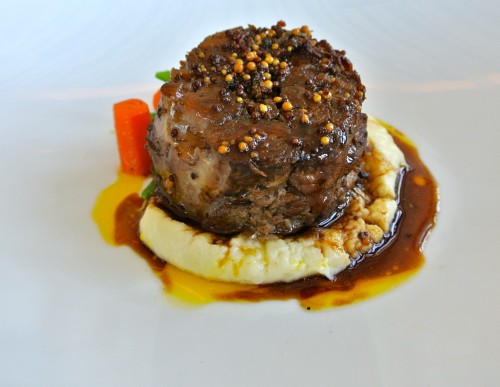
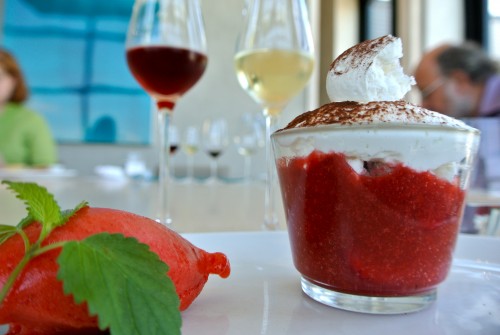
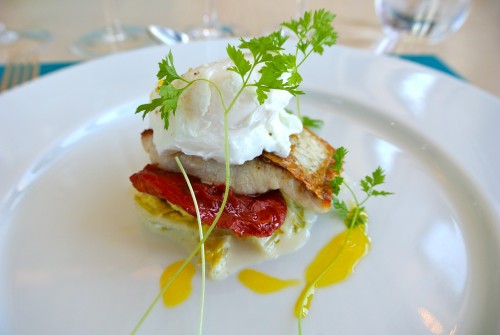 Treadwell dazzled with his seared whitefish with creamed cabbage and dried tomato and soft poached egg (above) and served with Stratus White 2010. His “savoury” dish was a Cumbrae Farms slow cooked lamb shoulder with pomme puree and summer vegetables (above middle) served with Stratus Red 2010. The finishing master stroke was the Treadwell strawberry “mess” with vanilla bean whipped cream and crunchy meringue (above top) served with both the Stratus Icewine White 2013 and the Stratus Icewine Red 2012.
Treadwell dazzled with his seared whitefish with creamed cabbage and dried tomato and soft poached egg (above) and served with Stratus White 2010. His “savoury” dish was a Cumbrae Farms slow cooked lamb shoulder with pomme puree and summer vegetables (above middle) served with Stratus Red 2010. The finishing master stroke was the Treadwell strawberry “mess” with vanilla bean whipped cream and crunchy meringue (above top) served with both the Stratus Icewine White 2013 and the Stratus Icewine Red 2012.
Here’s what I liked from the tasting.
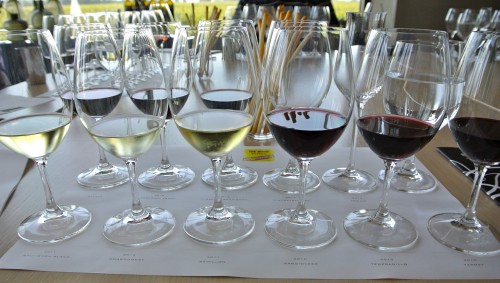 Stratus Sauvignon Blanc 2011 ($29, winery, 90 points) — “I try to make Sauvignon Blanc on the frontier of both worlds,” explains Groux. “I don’t like the extremes of New Zealand and California.” I don’t think anyone would confuse this 2011 as being similar to either of those extremes. The wine spends nearly two years in 25% new French oak giving it an air of elegance on the nose to go with gooseberry, soft tropical fruits, herbal notes and spicy accents. It is tightly wound at the moment but the fruit opens up with a little coaxing, showing a powerful array of flavours bolstered by fine oak and spice. Should improve for a few years to come.
Stratus Sauvignon Blanc 2011 ($29, winery, 90 points) — “I try to make Sauvignon Blanc on the frontier of both worlds,” explains Groux. “I don’t like the extremes of New Zealand and California.” I don’t think anyone would confuse this 2011 as being similar to either of those extremes. The wine spends nearly two years in 25% new French oak giving it an air of elegance on the nose to go with gooseberry, soft tropical fruits, herbal notes and spicy accents. It is tightly wound at the moment but the fruit opens up with a little coaxing, showing a powerful array of flavours bolstered by fine oak and spice. Should improve for a few years to come.
 Stratus Chardonnay 2012 ($48, 91 points, previously reviewed and retasted) — The Stratus 12 Chardonnay follows in the footsteps of the opulent 2010 Chardonnay with poached pear, vanilla, toasted oak accents and spice on the nose. It’s another rich and textured style of Niagara Chardonnay, with 100% wild fermentation and full malo that Stratus is championing with succulent and highly extracted fruit, beautiful oak spices, buttery-vanilla notes and fairly decent acidity. It’s a big, fleshy style that shows the vintage and puts the ripe fruit front and centre.
Stratus Chardonnay 2012 ($48, 91 points, previously reviewed and retasted) — The Stratus 12 Chardonnay follows in the footsteps of the opulent 2010 Chardonnay with poached pear, vanilla, toasted oak accents and spice on the nose. It’s another rich and textured style of Niagara Chardonnay, with 100% wild fermentation and full malo that Stratus is championing with succulent and highly extracted fruit, beautiful oak spices, buttery-vanilla notes and fairly decent acidity. It’s a big, fleshy style that shows the vintage and puts the ripe fruit front and centre.
Stratus Semillon 2011 ($38, 89 points) — The grapes for this Semillon were picked in the second week of November with the alcohol measuring a whopping 15.5%. Groux decided to implement reverse osmosis to bring the heat down to a more palatable 11.5%. I love the nose of honeycomb, pear, guava, peach, grapefruit and spice. It shows perfect balance in the mouth with lanolin, peach, lemon, spice and brisk acidity.
 Stratus Sangiovese 2010 ($42, 91 points) — This limited release (40 cases) marks the first time Stratus has made a single-varietal Sangiovese. The fruit from these 10-year-old vines in previous years found its way into one of the winery’s blends. It’s an intriguing take on this Italian staple with a meaty nose of plums, raspberry jam, cherry, forest floor and soft spicy notes. It’s perfectly aged with soft and approachable cherry-plum fruits, smooth tannins and integrated spice notes.
Stratus Sangiovese 2010 ($42, 91 points) — This limited release (40 cases) marks the first time Stratus has made a single-varietal Sangiovese. The fruit from these 10-year-old vines in previous years found its way into one of the winery’s blends. It’s an intriguing take on this Italian staple with a meaty nose of plums, raspberry jam, cherry, forest floor and soft spicy notes. It’s perfectly aged with soft and approachable cherry-plum fruits, smooth tannins and integrated spice notes.
Stratus Tannat 2010 ($42, 88 points) — Another first release as a single varietal and limited to 47 cases. It’s a dark colour, almost opaque, with thick blackberry, jammy blueberry, graphite and floral-spice notes on the nose. It’s a big wine on the palate with concentrated dark fruits, sweet spices and a huge wall of tannins that need time to soften.
Stratus Cabernet Franc 2010 ($38, 92 points) — I love the maturity of this aged Franc from the warm 2010 vintage. The wine was aged for 578 days in 31% French oak. The nose is expressive with cherry, raspberry, cedar, roasted herbs, intense spice and a lovely subtle floral note. Everything is in balance on the palate with delicious red fruits, tobacco leaf, spice and energizing acidity. It still has the tannic structure to provide pleasure for years to come.
Note: I also got to taste a barrel sample of a botrytised Semillon picked in December 2012. It’s not yet bottled, but, you heard it here first, this is worth lining up for. The barrel sample was breathtaking.






Comment here